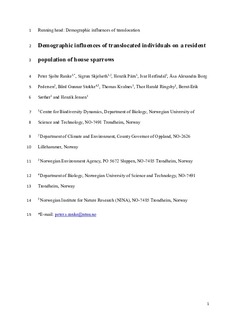| dc.contributor.author | Ranke, Peter Sjolte | |
| dc.contributor.author | Skjelseth, Sigrun | |
| dc.contributor.author | Pärn, Henrik | |
| dc.contributor.author | Herfindal, Ivar | |
| dc.contributor.author | Borg Pedersen, Åsa Alexandra | |
| dc.contributor.author | Stokke, Bård Gunnar | |
| dc.contributor.author | Kvalnes, Thomas | |
| dc.contributor.author | Ringsby, Thor Harald | |
| dc.contributor.author | Sæther, Bernt-Erik | |
| dc.contributor.author | Jensen, Henrik | |
| dc.date.accessioned | 2017-10-30T13:24:05Z | |
| dc.date.available | 2017-10-30T13:24:05Z | |
| dc.date.created | 2017-03-17T05:49:03Z | |
| dc.date.issued | 2017 | |
| dc.identifier.citation | Oikos. 2017, 126 (10), 1410-1418. | nb_NO |
| dc.identifier.issn | 0030-1299 | |
| dc.identifier.uri | http://hdl.handle.net/11250/2462911 | |
| dc.description.abstract | Translocation of individuals from source populations to augment small populations facing risk of extinction is an important conservation tool. Here we examine sex-specific differences between resident and translocated house sparrows Passer domesticus in reproductive success and survival, and the contribution of translocated individuals to the growth of a local population. We found evidence for assortative mating based on origin revealed by fewer parentages between translocated males and resident females than expected, and the total number of fledglings produced by such pairs was lower. The reproductive success of translocated males was positively related to the size of the throat badge (a sexual ornament), such that only translocated males with a large badge size were as successful as resident males. However, offspring with parents of different origin had higher survival than offspring with parents of the same origin, which suggests hybrid vigour. The contribution of resident and translocated individuals to the stochastic component of the long-run growth rate of the population was similar; neither the mean individual contributions in fitness nor the demographic variance differed between the two groups. Thus, this experiment shows that translocated individuals may have a similar demographic influence on the growth of local populations as resident individuals. Still, the intermixing of translocated and resident individuals was low, and fitness differed according to origin in relation to individual differences in a sexually selected trait. In addition, hybrid vigour with respect to offspring recruitment seemed to partially decrease the negative fitness consequences of the assortative mating based on origin. | nb_NO |
| dc.language.iso | eng | nb_NO |
| dc.publisher | Nordic Ecological Society for Oikos Editorial Office | nb_NO |
| dc.title | Demographic influences of translocated individuals on a resident population of house sparrows | nb_NO |
| dc.type | Journal article | nb_NO |
| dc.type | Peer reviewed | nb_NO |
| dc.description.version | acceptedVersion | nb_NO |
| dc.source.pagenumber | 1410-1418 | nb_NO |
| dc.source.volume | 126 | nb_NO |
| dc.source.journal | Oikos | nb_NO |
| dc.source.issue | 10 | nb_NO |
| dc.identifier.doi | 10.1111/oik.04065 | |
| dc.identifier.cristin | 1458935 | |
| dc.relation.project | EU/268562 | nb_NO |
| dc.relation.project | Norges forskningsråd: 223257 | nb_NO |
| dc.relation.project | Norges forskningsråd: 221956 | nb_NO |
| dc.description.localcode | This is the peer reviewed version of the following article: [Demographic influences of translocated individuals on a resident population of house sparrows], which has been published in final form at http://onlinelibrary.wiley.com/doi/10.1111/oik.04065/abstract. This article may be used for non-commercial purposes in accordance with Wiley Terms and Conditions for Self-Archiving. Locked until 24.4.2018 due to copyright restrictions. | nb_NO |
| cristin.unitcode | 194,66,10,0 | |
| cristin.unitname | Institutt for biologi | |
| cristin.ispublished | true | |
| cristin.fulltext | postprint | |
| cristin.qualitycode | 1 | |
